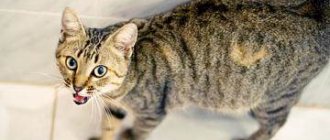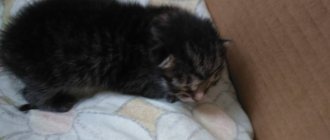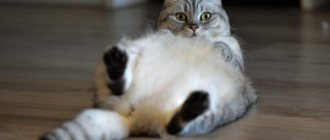If you are a happy cat owner, then without sterilizing your pet, sooner or later she will give you a litter of wonderful kittens. It’s good if this event is planned, then the cat will receive the nutrition, care and attention of all family members necessary during pregnancy. In this case cat giving birth will be carried out under the close supervision of the owner or veterinarian, which will help cope with possible difficulties or complications.
Although childbirth is a natural process, unplanned situations cannot be ruled out, so it is worth preparing for the climax long before it begins, which is what this article will help you with.
global $ads_google; //data-ad-slot=”2475549904″ $ads_google = empty($ads_google) ? false : true; ?> if ($ads_google == false) {?> $ads_google = true; ?> } ?>
How to prepare a cat for birth
A caring owner begins to prepare the cat for childbirth even before mating begins.
It is important to make sure that the pussy is healthy: an active lifestyle of the animal will contribute to the normal course of pregnancy and childbirth. However, towards the end of the term, it is better to ensure that the cat does not try to “take heights”, does not jump from cabinets and other high objects in the house: it can easily fall on its stomach.
On the contrary, you should try to stimulate British cats during pregnancy - these sloths are quite capable of lounging on the bed for a long period of time. And low mobility will not lead to a good result.
It is better to contact the veterinary clinic in advance and find out whether you can get an urgent consultation at any time of the day at “hour X”, and whether the institution provides the opportunity to give birth to cats at home .
Preparing the birth site
Just as a woman needs a breeding room, a cat needs a place to give birth to her offspring. It is best if it is something resembling a house for giving birth to a cat. In this place, not only will the fluffy balls be born, but also their first weeks of life will pass.
Why is it so important to prepare a place for your cat to give birth in advance? If she does not feel calm and protected, she will begin tossing around before the onset of labor, and then frantically dragging the kittens in search of a safe place.
How to help your beloved pussy during childbirth? Take care of everything in advance! What to make a house from: any spacious box will do, preferably with a removable top lid. A disposable absorbent diaper is placed in it. It makes sense to prepare in advance all the items that will help during obstetrics and place them close to the “maternity” house.
Infertility and multiple pregnancy: what affects fertility
There are many theories why cats give birth to different numbers of kittens and what this depends on. Among the most widespread are:
- Influence of nutrition. If there is insufficient or poor quality food, the cat's chances of becoming pregnant are reduced. Nature seems to protect dead and weak kittens from being born. This is called nutritional infertility.
- Obesity. At the same time, many animals stop estrus, which indicates serious hormonal changes in the body. And in this condition, pregnancy cannot occur at all.
- Comfortable living conditions: cleanliness, comfort, favorable emotional climate, absence of stressful situations and other factors.
- Heredity. If the cat's mother gave birth to a small number of kittens, then you should not expect multiple pregnancies from your pet.
- Diseases of the reproductive system that affect the ability to conceive. For example, endometritis, pyometra and others.
- Temperament of a cat. Ovulation in cats occurs under the influence of the active behavior of the male during intercourse. Accordingly, the more active the partner is, the more eggs will be released and their fertilization will occur. If the cat is phlegmatic, there will be fewer kittens.
- Just like people, pets can be incompatible with each other. Therefore, if there is no pregnancy from a particular partner, you can try to change him.
- The quality of a cat's sperm also plays an important role. With prolonged abstinence or frequent sexual intercourse, it decreases sharply. It also depends on the living conditions of the animal, the psychological climate, healthy food, the general condition of the body, the absence of chronic diseases, etc.
- Hormonal imbalance in a cat, in which little follicle stimulating hormone (FSH) is released, which leads to the release of a small number of eggs. This, in turn, also applies to low-fertility pregnancies.
- Weight, age and general condition of the expectant mother’s body. Older cats give birth to fewer kittens.
- Pedigree and barn cats have different fertility rates. The latter most often give birth to many kittens, and this trend does not change with the age of the pet. Animals with blue blood have a tendency to have low-fertility pregnancies.
- Some breeders believe that the number of offspring is related to the number of matings. After the first time, one or two kittens are born, by 7 - the maximum possible for a given individual, and then their number decreases again.
- Another opinion is that the faster intercourse occurs from the beginning of estrus, the greater the number of new pets will be born.
All these theories have both confirmation and refutation. For example, if you adhere to the opinion that nutrition and stress affect pregnancy, it turns out that yard cats that do not have owners should not give birth at all, but they bring the maximum number of pets and calmly bear and raise them in the future. At the same time, females who are in calm home conditions with sufficient nutrition and care cannot always please their owners with kittens.
Also read about discharge from a pregnant cat.
First birth of a cat
Starting from 7-9 months, the cat is capable of reproduction. But don’t rush things: it’s much better if the pussy turns one year old, when 3-4 heats have passed. If the mating is successful, the cat's birth calendar will help calculate the timing of the birth of the offspring.
The first time is scary for everyone: both the cat and the owner. But nature took care of the animal’s strong instincts, so sometimes it’s enough for a person to just be nearby.
The first birth is quite normal if the cat is healthy. First, contractions intensify, followed by a reduction in the intervals between them.
After pushing, the baby appears, but first amniotic fluid will come out of the birth canal. The cat will want to sit down while the kitten is coming out, this should not be allowed!
The interval between the appearance of kittens during the first birth can frighten the owner - a break of up to one and a half hours is considered the norm, and labor itself lasts from several hours to one day. In some cases, labor lasts up to 36 hours
Since the cat is inexperienced, you can help her during childbirth and cut the umbilical cord with scissors at a distance of 2 cm from the kitten’s belly.
When labor is too long
Now that we've explained how long it takes to deliver kittens, we should know that veterinary intervention is recommended in some circumstances. These may include:
- If more than 2 hours have passed since contractions began.
- Very weak contractions for 2 to 4 hours.
- After 20-30 minutes, very strong contractions without expelling the kitten.
- If we see obstruction of the birth canal, regardless of time.
Any of these signs could indicate a problem with the mother or babies and we would have to contact a veterinarian. They will be able to best diagnose the problem and even perform a caesarean section if necessary.
Signs of labor in a cat
In order not to miss the onset of labor, owners carefully observe how the cat behaves before giving birth:
- a few weeks before lambing, you can easily notice the enlargement of the mammary glands;
- 1-2 days before the important moment, colostrum is slowly released;
- unusual behavior of a cat is difficult to ignore: this is the search and arrangement of a “nest”, changes in mood, anxiety, desire to hide, or extraordinary affection;
- drop in body temperature to 37°;
- appetite may disappear completely;
- The cat often licks the genitals.
The main thing is to let the pet feel that she is not alone: talk to her tenderly, pet her, arrange a House for her in a secluded corner.
global $ads_google; //data-ad-slot=”2475549904″ $ads_google = empty($ads_google) ? false : true; ?> if ($ads_google == false) {?>
$ads_google = true; ?> } ?>
What is not recommended to do before labor begins
To ensure a smooth birth, pay attention to the list of things you should not do:
- irritate the woman in labor with loud screams, numerous guests, parties;
- actively feel the stomach, as you may accidentally injure the cat or kittens;
- Give your cat medications on your own without consulting a specialist;
- ignore vomiting, discharge and changes in the behavior of the pregnant woman;
- allow your cat to come into contact with animals whose health status you do not know;
- allowing you to sleep in a dirty place, handling the animal with dirty hands, frequently changing the linen in the cat’s sleeping area;
- use chemicals to clean the house.
Stages of lambing for a cat
Labor is divided into three stages:
- Contraction of the uterus and its gradual opening. The external symptom is discharge - the mucous plug that covers the entrance to the cervix comes out. Contractions appear and become more frequent.
- Increased frequency of contractions, complete opening of the cervix. The movement of the fetus along the birth canal into the second phase is accompanied by the mother cat’s attempts to push the baby out: the animal tenses. Kittens are born mainly in the amniotic sac. If the new mother did not help the child cleanse himself of it and did not lick it, then a person should help - carefully use scissors to make an incision on the bubble in the area of the muzzle, and the kitten itself is wiped with a cloth. Usually the female, on her own, carries out the procedure of breaking the bladder and licking its remains from the kitten’s body. The duration is 5-60 minutes.
The kitten did not come out an hour after the start of this stage? Urgent call to the vet!
- Once the baby is born, the placenta begins to come out, which the mother can eat after the kitten has been licked. It is better to remember how many placentas came out - there should be as many of them as kittens.
The kitten finds the nipple, labor resumes, and the next cub appears. The interval between two kittens can be from 10 to 60 minutes.
The whole process takes on average 6 hours.
Nuances of the prenatal period in a cat
The pregnancy time of a cat directly depends on its breed and health status. To avoid troubles, you need to monitor changes in the behavior of the expectant mother, observe the well-being of the animal, and have basic knowledge of physiology.
- Signs of pregnancy. Be prepared for the fact that during the first 2.5 weeks it is impossible to detect pregnancy in a cat without an ultrasound examination. And already in the third week, certain changes begin to occur in the animal’s body. She may vomit and become lethargic, and her mood will change at lightning speed. In addition, you will notice that the nipple area has become significantly pinker. By 6-7 weeks, the belly will become rounded, and the mammary glands will greatly increase.
- Duration of pregnancy. As mentioned earlier, the duration of an animal’s pregnancy depends on the health and breed of the pet. The most popular Scottish cats now bear cubs from 63-67 days from the moment of mating, and in British cats pregnancy lasts 64-66 days. Persians carry babies longer than all other breeds, and Siberian breeds give birth a little earlier. On average, this figure is 62-66 days, and in case of complications or any pathologies, the duration can be reduced to 57 days.
- How is pregnancy progressing? Complications often arise when a cat gives birth for the first time, and mainly in purebred pets bred artificially. During such periods, the animal’s general condition noticeably worsens, and the expectant mother begins to whine in her sleep, stops eating, and becomes apathetic. The expectant mother does not want to get up on her paws, and she practically goes into “lying down” mode.
- Precautionary measures. When pregnancy is diagnosed, try to carry your pet less often, and do not lift or press the woman in labor, especially when her stomach is already enlarged. Also, you should not knead your belly in the hope of finding the offspring, as there is a possibility of harming the pet. It happens that, without meaning to, the owners accidentally touch the cat while walking, and it hisses. This is a defensive reaction, because the mother is already trying to protect her future offspring. Try to avoid this, as there is a possibility that such cats will become aggressive after lambing.
Giving birth to a cat at home
A responsible owner should know how to give birth to a beloved cat . First, prepare everything you need:
- a house that the cat will examine and “accept” in advance;
- towels or absorbent diapers;
- clean cloths or gauze;
- thick silk thread;
- scissors with rounded ends;
- alcohol for disinfecting scissors;
- hydrogen peroxide;
- streptocide in powder form;
- a pipette or syringe that can be used to suck out liquid from the baby’s nose;
- afterbirth bowl;
- warmer.
Easy birth
A cat's birth is considered easy when there is no need for human intervention. It will be enough to simply be close to the woman in labor. The main thing you need to take care of is that the mother should not accidentally crush her offspring. It is also important to monitor whether each afterbirth has come out. If suddenly some placenta is missing, then the cat’s discharge is observed for several more hours; the process may take a little longer.
An easy birth is not characterized by pus, mucus and blood.
Middle birth
Sometimes some complications arise during home birth. If the process is delayed, you need to stroke the cat from the side of the neck to the uterus.
If the cat is distracted and does not chew the umbilical cord, a person does this, treating the cut site with iodine. The newborn may not breathe: minor resuscitation will be required. The respiratory tract is cleared of mucus using a pipette or suction, and the oral cavity is examined. Anything that should not be there is removed with a rubber bulb. If breathing does not appear, the baby is picked up and carefully folded in half - several times in a row. You can also rub the baby with a rough towel and gently shake it upside down.
Difficult birth
global $ads_google;
//data-ad-slot=”2475549904″ $ads_google = empty($ads_google) ? false : true; ?> if ($ads_google == false) {?> $ads_google = true; ?> } ?> Childbirth turns out to be difficult when, despite everything, the kitten is not born on its own: the baby gets stuck in the birth canal, or two babies try to be born at the same time. Before calling the veterinarian and hoping for a caesarean section, there are a number of independent steps to take.
You need to understand that it is better to act and help the cat during childbirth than to later regret the misfortune that happened.
If labor stops or its result is zero, the cat can be taken for an ultrasound or x-ray. It may turn out that the kitten has died, or it is extremely large and has blocked the exit.
Sometimes it is necessary to turn the kitten over: a gloved index finger, lubricated with Vaseline, is inserted into the vagina. You need to carefully push the baby back and try to turn him over. If it is simply stuck, then it is picked up under the hanger and carefully pulled out with attempts.
What to feed a pregnant cat
A cat preparing for the birth of offspring should be fed high-calorie food enriched with vitamins and minerals.
In the first two weeks of pregnancy, the cat's appetite will increase, so the amount of food should be increased by 10%. The animal must be fed 4 times a day in small portions.
From the 3rd week of pregnancy, the cat's appetite is maximum. It is necessary to increase the volume of food by 50%, but in no case should she be allowed to overeat; she should be fed 5-6 times a day in fractional portions.
A cat's diet should include:
- meat (chicken, beef, turkey);
- egg yolk;
- vegetables (carrots, cabbage);
- dairy products (kefir, cottage cheese, yogurt, sour cream);
- cereals and cereals (buckwheat, rice, wheat);
- a small amount of fish.
If you feed your pet dry food, then choose food for pregnant cats, and then for nursing mothers.
To increase your cat's lactation, give her fresh nettle, but first pour boiling water over the herb so as not to burn the cat's internal organs and mouth.
Induction of labor
If the due date has come, the cat’s body temperature has dropped to 37°C, more than two days have passed, then you need to know how to induce labor in a cat. First, they try simple remedies: massage the tummy and nipples: this will cause the production of oxytocin, and it will start the process of contractions. It is dangerous to administer oxytocin on your own - physiological unpreparedness for lambing can lead to cervical rupture.
If two days have already passed, signs of labor are evident, but the process has not started, then contact a veterinarian.
Childbirth: how long should it last in theory and in practice
We are interested in the first stages of childbirth, at the moment of which the offspring are born. Immediately after the stage accompanied by a decrease in general body temperature, the main stage of the birth process begins. During this period, the cat begins to become very worried and nervous (this is especially true for primiparous animals).
You may notice shortness of breath, a sudden increase in your pet's activity, or a refusal to eat. In rare cases, vomiting is observed (but during normal labor it is quite rare). The cat also exhibits "nesting" behavior. Once again, show your pet the box or basket in which she should give birth. Talk to the animal, stroke it, calming it down. Sometimes placing some old clothes in the basket, saturated with the owner's scent, helps. This “aromatherapy” calms many cats, as a result of which the pet no longer tries to escape and give birth on your bed.
So, the first stage normally lasts from 6 to 12 hours . During this period, the cervix should fully dilate and relax. In cases where, after 24 hours, no signs of the onset of labor appear, we strongly advise you to seek help from a veterinarian.
Possible complications
Cats are naturally strong creatures, but sometimes complications still occur. This was especially influenced by breeding selection. Observations have shown that Persian and Siamese cats often “delight” their owners with dystocia—difficult childbirth. When choosing a female kitten, it is better to immediately ask the breeders how the birth of kittens for this particular breed goes.
Bloody discharge in a cat after birth
Sometimes during labor a cat notices ichor oozing out. This is most often described as “my cat peed blood.” This is quite normal if there is little bleeding.
The alarming symptom normally disappears completely two days after lambing.
Sometimes there are really serious problems, expressed by bleeding from the vagina. Blood may have accumulated in the uterus, or if there are tears in the uterus or vulva. If a caesarean section was performed, then the blood may indicate broken sutures. But this is not just some bleeding, but really heavy bleeding that does not stop after 10 minutes. In this case, urgent veterinary help is needed.
The cat does not have milk after giving birth
First, felines, like humans, secrete colostrum. But when does a cat produce milk after giving birth? Colostrum is milk, only with a slightly modified composition. Colostrum contains a huge amount of maternal antibodies. After 2-3 days, colostrum is replaced with full-fledged nutritious milk. Thanks to nature, which, through the process of evolution, “thought out” everything, and the cat itself feeds its offspring!
But what if the cat gave birth, but there is no milk? There are several reasons: stress during a difficult birth, fear of the first-born cat, dormant maternal instinct.
The animal is provided with a comfortable environment, a nutritious, balanced menu, and milk is not spared. The bowl with food and drink is placed closer to the cat family. If food is far away, the mother may fear for her offspring, which also affects the quality and quantity of milk.
If milk does not appear, you will have to feed the newborn kittens yourself.
After giving birth, the cat came out with a bladder
Sometimes you can see a bubble coming out of the cat. Usually, this is the amniotic membrane - the kitten was in it before birth. During the normal course of labor, such a bubble ruptures inside the animal.
Sometimes during labor a bubble appears first. The cat may try to tear it apart, but the owner’s job is to prevent her from doing this. As soon as the bubble with the kitten comes out completely, you can break the shell.
If after giving birth a cat has an empty bladder, this is simply a developmental variation within the cat’s body, and it does not cause problems.
After childbirth there was a belly
global $ads_google;
//data-ad-slot=”2475549904″ $ads_google = empty($ads_google) ? false : true; ?> if ($ads_google == false) {?> $ads_google = true; ?> } ?> The cat has become a mother, the kittens are snoring nearby, but the pet still has a belly. This is the probability that not all babies were born at once. It is optimal to wait 12 hours and allow the natural process to take its course. But if the next day has already arrived and nothing has happened, then you definitely need to consult a veterinarian.
To make sure that not all the babies have come out, the cat’s stomach is felt. It is especially dangerous if the kitten is dead inside. If the baby inside cannot be felt, there is a possibility that the pet has intestinal problems: constipation, flatulence, feces, helminthic infestation.
Eclampsia in cats after birth
Eclampsia is a severe postpartum condition that is not that rare. Due to the production of milk, the amount of calcium in the animal’s blood decreases, and it may even cease to be absorbed by the body.
Signs of eclampsia:
- excessive saliva production;
- poor coordination of the animal, confused movements;
- concern;
- convulsions;
- the temperature rises.
If you notice these warning signs, contact your doctor immediately! Further development of the complication leads to death.
To avoid such danger, during pregnancy and after the birth of kittens, the cat is given calcium supplements. But first, they take a blood test to determine the need for such prevention.
Cat doesn't eat after giving birth
The norm is that a cat should not be hungry for another 5-6 hours after birth.
The main thing is that the pet does not refuse water. If the cat has not eaten for a long time, first she is offered broth. Low-fat cottage cheese, kefir, and even sweet tea can cause your pet’s appetite.
If your cat develops diarrhea, it means she has eaten too much afterbirth. With such a disorder, refusal to eat is understandable. The treatment will be sorbents and Ringer's solution. This will relieve intoxication. Enveloping substances will help protect the mucous membranes. Ringer's solution will prevent dehydration.
As soon as the cat feels better, she will ask for food herself.
The cat does not go to the toilet after giving birth
The body and uterus will gradually recover after the end of labor, so the animal does not rush to the tray. Don't panic if you brought the tray closer to her and the new mother ignored it.
It is considered normal if the cat does not go to the toilet after giving birth for up to 4 days.
The lack of desire to visit the latrine may be caused by exhaustion - all the liquid goes into the milk.
Publications in the media
Childbirth is a complex physiological process of expulsion of the contents of the uterine cavity (fetus, amniotic fluid, membranes and placenta) through the natural birth canal.
Reasons for the onset of labor • The placental clock is a hypothetical mechanism that determines the duration of pregnancy and the date of birth. When studying the content of placental corticoliberin in the blood of 485 pregnant women (McLean et al., 1995), it was found that already at 18 weeks of pregnancy, groups with normal, premature and late births can be distinguished. By the time predicted for these groups, the blood level of corticoliberin increases sharply. Perhaps this placental hormone is a signal of the onset of labor. • PGs promote the entry of Ca2+ into the myoplasm of SMCs, which leads to their contraction and the development of contractions. Reflex irritations (for example, manipulation of the cervix, rupture of membranes) lead to stimulation of Pg synthesis. • Oxytocin, synthesized both in the body of the pregnant woman and in the fetus, ensures the release of Pg and the release of a large number of other substances that stimulate myometrial contraction (serotonin, catecholamines, etc.). • Decreased progesterone levels. Labor is a process accompanied by contractions that occur with increasing frequency and intensity and lead to dilation of the cervix, the birth of the fetus and placenta. A distinction is made between the preparatory period (harbingers of childbirth) and true childbirth. • Precursors of labor include increased urination, the appearance of bloody-mucous discharge from the vagina, painless irregular contractions of the uterus (Braxton Hicks). The preparatory period for childbirth normally begins at 38 weeks. At this time, a number of changes occur in the pregnant woman’s body •• Formation of a generic dominant in the central nervous system - a stagnant focus of excitation that regulates preparation for childbirth and the process of childbirth itself. Clinically accompanied by drowsiness, calm behavior, a decrease in the pregnant woman’s body weight 7–10 days before birth by 800–1000 g •• Change in the ratio of estrogen and progesterone due to an increase in the level of estrogen, especially estriol, which provides the formation of receptors for Pg, oxytocin, serotonin, kinins and other biologically active substances that increase the excitability of the uterus •• The predominance of the influence of the adrenergic (sympatho-adrenal) nervous system •• Structural changes in the cervix. The mature cervix is located along the pelvic axis. The cervix is shortened to 1–1.5 cm, completely softened, the internal os is soft, smoothly passes into the lower segment of the uterus. The cervical canal freely allows a finger to pass through (opened by 2–3 cm), the length of the vaginal part of the cervix corresponds to the length of the cervical canal •• Tight pressing of the presenting part of the fetus to the entrance to the pelvis •• Detachment of the lower part of the amniotic sac from the walls of the uterus •• Appearance of mucous - bloody vaginal discharge (discharge of the mucous plug of the cervix).
• Characteristics of uterine contractions during childbirth . Labor contractions differ from preparatory contractions in the frequency (at least 1-2 times per 10 minutes) and strength of contractions, as well as in the sequential anatomical changes of the cervix (shortening, smoothing and opening). Periods of labor • The first period (dilation) begins with the first contraction. During the first stage of labor, contractions become quite frequent, intense, prolonged and cause smoothing and dilation of the cervix. The period of dilation ends with the transition of contractions to pushing and the discharge of amniotic fluid • The second period (expulsion). In the second stage of labor, the fetus is expelled. This period begins with the full dilatation of the cervix, the transition of contractions to attempts and ends with the birth of the child • The third period (successional). The beginning is the moment of the birth of the child, the end is the separation of the placenta and the birth of the placenta. Birth in occipital presentation . Occipital (parietal) presentation is observed in 95% of all births. It is necessary to distinguish between positions and types of fetal positions. Position determines the location of a randomly selected part of the fetus (in this case, the occiput of the fetus) in relation to the right and left sides of the birth canal. More strictly, the position is defined as the location of the fetal back in relation to the right and left sides of the uterus. The type of position is defined as the ratio of the fetal back to the anterior or posterior side of the uterus. • Positions for occipital presentation •• First (left) position. In occipital presentation and the first position, the fetal back is turned to the left, the small fontanel is located closer to the left side of the uterus, and the large fontanel is closer to the right •• Second (right) position. With occipital presentation and the second position, the location is reversed (i.e., the back of the fetus is facing to the right, the small fontanelle is located closer to the right side of the uterus). • Types of positions for occipital presentation •• Anterior view. The sagittal suture of the fetal head forms an angle of 45° with the transverse size of the pelvis, the back of the head is turned anteriorly and faces to the right or left •• Posterior view. Posterior breech births account for approximately 1% of all occipital breech births. The diagnosis of posterior view is made only in cases where the back of the fetal head remains facing the sacrum of the woman in labor in the plane of the pelvic outlet. The second (right) position is observed much more often than the first (left). The posterior view is often combined with a narrowing of the entrance to the pelvis. Seven main fetal movements during childbirth. The process of adjusting the position of the fetal head to pass through various planes of the pelvis is necessary for the birth of a child. These changes in the position of the presenting part constitute the biomechanism of labor and include 7 sequential movements. The domestic school of obstetricians in the anterior form of occipital presentation identifies four moments of the mechanism of labor, corresponding to 3, 4, 5 and 6 fetal movements during labor according to the American classification. • Insertion of the head - the position of the fetal head at the moment of crossing the plane of the entrance to the pelvis. The insertion is considered normal if the vertical axis of the head is perpendicular to the plane of the entrance to the pelvis, and the sagittal suture is approximately the same distance from the promontory and the pubic symphysis. Normal insertion is called axial or synclitic. For any deviation, the insertion is considered asynclitic. • Promotion. The first condition for the birth of a child is the movement of the fetus through the birth canal. If insertion of the fetal head has already occurred at the onset of labor (in primigravidas), progress can be observed before the start of the second stage of labor. In multiparous women, advancement usually begins simultaneously with insertion. • Flexion of the head. When the descending fetal head encounters resistance from the cervix, pelvic walls and pelvic floor, the head normally flexes. This is the first moment of the labor mechanism according to the domestic classification •• The chin approaches the chest •• As a result of flexion, the fetal head is presented at its smallest size, equal to the small oblique size (9.5 cm). • Internal rotation of the head is accompanied by descent of the presenting part and is completed when the head reaches the level of the ischial spines. The movement involves a gradual rotation of the occiput anteriorly towards the symphysis pubis. This is the second moment of the mechanism of childbirth according to the domestic classification. • Extension of the head. Extension of the fetal head occurs after the area of the suboccipital fossa (fixation point) approaches the pubic arch; the back of the head is in direct contact with the lower edge of the pubic symphysis (fulcrum). The head extends around this fulcrum. This is the third moment of the mechanism of labor according to the domestic classification •• During extension, the parietal region, forehead, face and chin appear successively from the genital fissure. •• The expelling forces of contractions and abdominal muscles, together with the resistance of the pelvic floor muscles, contribute to the unfolding of the crown in the direction of the genital fissure. • External rotation of the head and internal rotation of the body. The born head returns to its original position. The back of the head returns first to an oblique position, and then to a transverse position (left or right). This movement is accompanied by a rotation of the fetal body, the shoulders are installed in the anteroposterior size of the pelvic outlet. This is the fourth moment of the mechanism of childbirth according to the domestic classification. • Expulsion of the fetus. After external rotation of the head, the anterior shoulder (fixation point) appears under the symphysis (fulcrum) and is then born. The perineum is soon stretched by the back shoulder. After the birth of the shoulders, the baby is born quickly.
MANAGEMENT OF LABOR Rupture of the membranes can occur at any stage of pregnancy • Signs - sudden release or leakage of clear fluid from the vagina. In a full-term pregnancy, delivery usually occurs within 24 hours after rupture of the membranes • There is a real danger of intrauterine infection (chorioamnionitis) with an anhydrous interval exceeding 12 hours, regardless of the time of labor. First stage of labor. On average, the first period lasts about 12 hours for primiparous women and about 7 hours for multiparous women. • Constant monitoring of the fetal heart rate begins immediately after the onset of contractions, because a sudden slowdown (less than 120 per minute) or increase in heart rate (more than 140 per minute) may indicate threatening or incipient fetal hypoxia. • Amniotomy is an artificial violation of the integrity of the membranes. Amniotomy is performed strictly according to indications: polyhydramnios, flat amniotic sac, marginal placenta previa, premature placental abruption, etc. • Labor is divided into two phases •• The latent phase of labor is the period of time from the onset of regular contractions until the appearance of structural changes in the cervix (3-4 cm dilation). The duration of this phase in primiparous women is 6.5 hours, and in multiparous women it is about 5 hours. •• The active phase of labor begins after the latent phase. The cervix quickly opens from 3 to 8 cm at a rate of 1.5–2 cm/hour in primiparous women and 2–2.5 cm/hour in multiparous women. In the active phase, there is an initial acceleration, maximum rise and deceleration (cervical dilatation from 8 to 10 cm). • Discoordination of labor during any dilatation of the cervix is manifested by the absence of further dilatation of the cervix (the main indicator of normal labor is progressive dilatation) •• Weakness of labor. The myometrial contraction curve is normal, but intrauterine pressure rises during contractions to less than 15 mmHg. Correction of this type of dysfunction is usually carried out by stimulating labor. Below are several schemes for labor stimulation (other schemes for stimulating labor are widely used in obstetric practice) ••• Intravenous administration of oxytocin - 1 ml (5 units) diluted in 500 ml of 5% glucose solution or 0.9% sodium solution chloride Begin administration at a rate of 6–8 drops/min, gradually accelerating by 5 drops every 5–10 minutes (but not more than 40 drops/min) ••• Intravenous administration of Pg is carried out using the same method ••• Combined administration of oxytocin and Pg. 2.5 IU of oxytocin and 2.5 mg of Pg are diluted in 500 ml of 5% glucose solution and administered intravenously, gradually increasing the rate of administration from 6–8 to 40 drops per minute •• Excessively strong labor is manifested by extremely strong and very frequent contractions and increased uterine tone. It occurs more often in women with increased general excitability of the nervous system. In such cases, labor lasts 1–3 hours. Such labor is called rapid. Oxytocin is not recommended for use in cases of uterine hypertonicity. Sedative therapy relieves pain, relaxes the mother's muscles and usually leads to normal labor. Second stage of labor. The second period lasts on average about 50 minutes for primiparous women and about 20 minutes for multiparous women. However, the second period can often extend to 2 hours, especially in primigravidas. Attempts arise during this period. • Delivery through the vaginal canal •• Birth of the head. With each attempt, the genital slit is stretched by the fetal head. At first, the head appears in the genital slit only during pushing, disappearing when it stops. This is called head cutting. Then the head protrudes more and more and does not go back in the intervals between attempts, the vulva does not close, the head erupts, which is accompanied by stretching of the vulvar ring. The forehead, face and chin emerge successively through the perineum •• The birth of the shoulders. In most cases, the shoulders appear immediately after external rotation of the head and are born independently. The anterior shoulder is born, retained under the symphysis, and the posterior shoulder rolls out over the perineum, and then the entire shoulder girdle is born. If it is difficult to remove the shoulders, insert the index finger from the back into the armpit of the front shoulder and tighten the shoulder, then release the back shoulder. Excessive traction with stretching of the fetal neck can lead to injury to the brachial plexus or the roots of the fifth and sixth cervical nerves, known as Duchenne-Erb palsy. • Assisting childbirth with cephalic presentation •• Regulating the advancement of the erupting head ••• During pushing, three fingers of the right hand hold the fetal head, preventing its extension ••• With strong pushing, they help with the left hand: carefully bend the fetal head, preventing its rapid advancement •• • In between attempts, the left hand is left on the fetal head, and the so-called “tissue borrowing” is performed with the right hand - the tissue of the labia minora and clitoris is carefully lowered from the fetal head, the stretched tissue of the vulvar ring is brought towards the perineum •• Removal of the head ••• After the birth of the back of the fetal head, the woman in labor is recommended to restrain her efforts, breathing deeply and rhythmically through her mouth ••• At this time, the tissue of the vulvar ring is lowered from the parietal tubercles of the fetus, the head is slowly straightened with the left hand, and the perineal tissue is removed from the fetal face with the right hand ••• When the skin of the perineum turns pale or the appearance of cracks, perineotomy or episiotomy is indicated to prevent rupture of the perineum ••• If the umbilical cord is entwined around the fetal neck after the birth of the head, you must try to remove the umbilical cord loop. If this is not possible, the umbilical cord is crossed between two clamps •• Release of the shoulder girdle ••• After the birth of the head, it is turned to face the woman's thigh to the right or left (depending on the position). At the same time, the shoulders rotate and stand in the direct size of the pelvis (internal rotation of the shoulders) ••• First, the front (upper) shoulder is cut through. It is pressed against the symphysis, and then the perineal tissue is lowered from the posterior (lower) shoulder •• Birth of the torso. After releasing the shoulders, the palms of the hands on both sides are placed on the fetal chest and the body is directed upward, and the lower part of the body is born. • Primary treatment of a newborn •• Immediately after birth, the mucus from the mouth and nose is sucked out of the head. After birth, the baby is placed in a tray covered with a sterile diaper. The umbilical cord cannot be pulled. The baby should be positioned at the same level as the mother in labor •• The assessment of the newborn is aimed at determining the adequacy of oxygenation and breathing of the newborn. This is usually done using the abbreviated Apgar score. The Apgar score has been proposed to assess the level of oxygenation, ventilation and degree of asphyxia according to uniform criteria to facilitate the exchange of information between personnel involved in neonatal resuscitation. Apgar assessment is performed 1–5 minutes after birth. Five signs are scored from 0 to 2: heart rate, depth of breathing, muscle tone, state of reflexes and skin color. The total Apgar score at the 5th minute of life is an indicator of the effectiveness of resuscitation measures and the depth of perinatal asphyxia •• The child’s eyelids are wiped with a sterile cotton swab (separate for each eye) and gonoblennorrhea is prevented using the Matveev-Crede method: freshly prepared 30% r is instilled into the eyes -r sulfacetamide (for girls to prevent gonorrhea, also in the genital area). Prevention of gonoblennorrhea is repeated 2 hours after birth •• Primary treatment of the umbilical cord. At a distance of 10–15 cm from the umbilical ring, the umbilical cord is treated with 96° ethyl alcohol, after which two sterile Kocher clamps are placed on it at a distance of 2 cm from each other. The umbilical cord is then cut between the applied clamps, and the baby end of the umbilical cord is wrapped together with the clamp in a sterile gauze pad. After preliminary blood sampling to determine the AB0- and Rh-belonging of the child’s blood, a silk ligature or clamp is applied to the maternal end of the umbilical cord at the genital fissure. •• Secondary processing of the umbilical cord. The baby, wrapped in a sterile diaper, is transferred to a heated changing table ••• Umbilical cord ligation. The umbilical cord is treated with 96° ethyl alcohol and tied with a thick silk ligature at a distance of 1.5–2 cm from the umbilical ring. The ligature is tied on one side of the umbilical cord, and then on the opposite side. The umbilical cord is cut 2–3 cm above the ligation site with sterile scissors. The surface of the incision is wiped with a sterile gauze swab and, after making sure that the ligature is applied correctly (no bleeding), it is treated with 5–10% alcohol solution of iodine or 5% solution of potassium permanganate ••• Instead of a ligature, a Rogovin bracket can be applied to the umbilical cord. Before applying the staple, the umbilical cord is examined under a light source, wiped with a cloth soaked in 96° alcohol, and the Wharton jelly is squeezed out with two fingers. Then a bracket is applied. The umbilical cord is cut off 0.4 cm above the bracket, wiped with a dry gauze swab and, after making sure that the bracket is applied correctly (no bleeding), the umbilical cord remnant is treated with 5% potassium permanganate solution ••• In the future, care of the umbilical cord remnant is carried out in the open way •• • In case of Rh- and A0-incompatibility between the blood of the mother and the child, the umbilical cord is processed differently. After the birth of the child, the umbilical cord is immediately clamped (without waiting for the pulsation of the blood vessels to stop). Since sometimes there is a need for an exchange blood transfusion, it is advisable to leave a piece of the umbilical cord 8–10 cm long, tying it with a silk ligature ••• When giving birth to twins, the maternal end of the umbilical cord must be ligated, because with monozygotic twins, the unborn fetus will lose blood •• To remove the cheese-like lubricant from those places where it especially thickly covers the skin of the fetus (for example, in the inguinal folds and armpits), use sterile cotton wool soaked in sterile petroleum jelly •• Having completed the primary toilet of a newborn, determine its weight, body length, circumference of the head and shoulders. Then they put bracelets made of sterile oilcloth on their hands with the surname, first name and patronymic of the mother in labor, birth history number, gender of the child, body weight and length, and date of birth written on them. The baby is wrapped in warm sterile linen (diapers, vests, blankets) and left on a heated changing table for 2 hours, after which he is transferred to the neonatal ward. • Episiotomy - dissection of the vulvar ring during childbirth, the most common surgical intervention in obstetric practice. After a cut, the perineum heals faster than after a rupture. There are median (in domestic practice - perineotomy) and mid-lateral episiotomy, i.e. dissection of the perineum along the midline or lateral to it. Indications: threat of perineal rupture; the need for fetal-friendly delivery during breech presentation, large fetus, premature birth; acceleration of labor due to obstetric pathology, acute fetal hypoxia; operative vaginal delivery. Third stage of labor (successional). The placenta is usually separated and delivered within 10-15 minutes after the baby is born. • Signs of separation of the placenta •• The uterus becomes spherical and dense •• Bloody discharge appears from the genital tract, flowing down the umbilical cord •• Schroeder’s sign: the fundus of the uterus rises above the navel and deviates to the right, because. the separated placenta descends into the lower segment of the uterus and vagina, pushing the uterus upward •• Alfeld's sign: elongation of the umbilical cord stump, indicating that the placenta has descended. The detached placenta descends into the lower segment of the uterus or into the vagina, while the ligature placed on the umbilical cord at the genital fissure descends along with the umbilical cord by 10–12 cm •• Küstner–Chukalov sign: when pressing with the edge of the palm on the suprapubic region, the umbilical cord is not retracted into the vagina (if the placenta has not separated, the umbilical cord retracts) •• The appearance of a protrusion above the symphysis as a result of the placenta descending into the thin-walled lower segment of the uterus •• Mikulicz’s sign: when the separated placenta descends into the vagina, an urge to push appears (not always) •• Klein’s sign: after After pushing, the umbilical cord stump does not retract into the genital slit. • Before releasing the placenta, the bladder is catheterized and the woman is asked to push. Under the action of the abdominal press, the separated placenta is easily born. • If the placenta is not born, external methods of releasing the placenta are used •• Abuladze's method: after a gentle massage of the uterus with both hands, collect the anterior abdominal wall of the woman in labor into a longitudinal fold, then ask the woman to push •• Genter's method (rarely used): asking the woman in labor to relax, hands, clenched into fists, placed on the bottom of the uterus in the area of the tubal angles and slowly press inward and downward •• Mitlin's method: a hand clenched into a fist is placed on the anterior abdominal wall above the pubis with the back side to the symphysis. The fist is moved upward, pressing it tightly against the anterior abdominal wall of the woman in labor. Having reached the fundus of the uterus, they press towards the spine and ask the woman to push •• The Credet-Lazarevich method is a less gentle technique; it is used when other methods are unsuccessful ••• After emptying the bladder, a gentle massage of the uterus is carried out ••• They cover the fundus of the uterus, placing the thumb on its anterior surface, and the rest on the back ••• Squeezing the uterus and pressing its bottom down along the wire axis of the birth canal, squeeze out the placenta •• If there is no effect, manual separation of the placenta is used. • After the birth of the placenta, it is necessary to check whether the placenta and membranes are damaged, and whether there are missing fragments retained in the uterine cavity •• Inspection of the placenta. Having placed the placenta with the maternal surface facing up, it is carefully examined. If the placenta is not damaged, it has smooth, even edges. There should be no loose, broken vessels •• Inspection of the membranes. The membranes must be intact. If a torn vessel is found between the membranes, it means there was an additional placental lobe remaining in the uterine cavity •• Milk test. Using a Janet syringe, milk is injected into the vessels of the umbilical cord. If there is a rupture in the placenta, milk leaks out through it •• Air sample. The afterbirth is immersed in water, then air is pumped into the umbilical cord vessels using a Janet syringe. If the placenta is damaged, bubbles of escaping air are visible •• Retention of parts of the placenta in the uterus is a complication of childbirth, leading to severe bleeding and septic postpartum complications. If it is determined that placenta particles remain in the uterine cavity, they are removed by hand (less often with a blunt curette). • Prevention of atonic bleeding . Contraction of the myometrium leads to vasoconstriction and stops bleeding. •• Administration of oxytocin (10 units intramuscularly or 20 units per 1000 ml of 0.9% sodium chloride solution intravenously) in the early postpartum period promotes uterine contraction and reduces blood loss. Ergometrine, methylergometrine are also used •• Yakubova's method (prevention of bleeding in the placenta and early postpartum periods): after the birth of the fetus and clamping of the umbilical cord, 0.5 ml of oxytocin is slowly injected intravenously in 20 ml of 40% glucose solution, after the birth of the placenta - 1.5 ml of oxytocin IM •• The use of methylergometrine until the end of the third stage of labor is not recommended, because it also causes contractions of the lower segment of the uterus, which can complicate the release of the placenta from the uterus •• Indications for the prevention of atonic bleeding: complicated obstetric history, overdistension of the uterus (polyhydramnios, multiple pregnancy, large fetus); use of antispasmodics and analgesics during childbirth; age indications (young and primiparous women over 30 years old), labor anomalies, anemia and other cases when bleeding can be expected.
ICD-10 • O80 Singleton labor, spontaneous delivery
Caring for a cat after birth
global $ads_google; //data-ad-slot=”2475549904″ $ads_google = empty($ads_google) ? false : true; ?> if ($ads_google == false) {?>
$ads_google = true; ?> } ?>
The cat must be carefully looked after. She is raising the young generation, which will stay with her for up to 8-10 weeks. In order for the cat to have the strength to do this after giving birth, it requires good nutrition and fresh water nearby.
What is useful to feed a cat after giving birth? Among industrially produced feeds, they use specialized products for pregnant and lactating cats.
For the first 12 days, a nursing mother’s menu includes easily digestible, nutritious and natural foods: fermented milk, vegetables, cereals, a small amount of boiled lean meat.
Artificially bred cat breeds (Chausie, Elf, Savannah, American Curl), as well as British cats, may suffer from a change in diet, so their menu remains unchanged.
After 12 days, the animal’s usual food, including fish, is added.
Every day, carefully check your pet’s nipples for the presence of mastitis.
Now you are prepared and will be able to have a second birth after a period of time!
Maternal care
As a rule, there are no special recommendations for caring for healthy, newly born kittens with a mother present. The programs of maternal instincts in cats are laid down at the highest level, so it is better to take care of a pet who has devoted a lot of effort to the complex birth process.
Once a cat begins to feed its cubs with milk, it needs good nutrition, rich in proteins, vitamins and beneficial microelements. If there is an acute issue about the distribution of offspring, babies can be taught to eat independently from the age of three weeks.
Sterilization of a cat after birth
A cat's birth may involve complications, one of which may require a caesarean section. Of course, this is not an indicator for sterilization, but still a clear sign of a problem in the reproductive system.
It does not seem possible that a loving owner would again subject a furry creature to another painful birth or another caesarean section. In these cases, the clinic is consulted about sterilization. If a cat is sterilized during a caesarean section, then the procedure is more dangerous than the one that will be prescribed according to plan. In addition to complications from the operation, the cat may refuse to feed its offspring.
When is a cat spayed after giving birth according to plan? Usually the procedure is prescribed at the end of lactation, that is, 2.5-3 months after the birth of kittens. The kittens are isolated, or a blanket is put on the cat - milk should stop forming.
The veterinarian will advise which method of sterilization is most suitable for the cat who gave birth.
How many kittens can a cat give birth to?
Another logical question from owners: how many kittens can a cat give birth to at one time (the first time or the maximum number)?
As a rule, for the first time a cat can give birth to 1 – 3 kittens, since the cat’s reproductive system is not fully formed. Older cats also give birth to a small number of kittens - their reproductive function fades.
How many kittens can a cat in her prime give birth to at one time? Typically up to 6 kittens. After all, nature has endowed a cat with only 8 nipples, which means that it is difficult for a cat to feed more than 8 kittens.
However, there are exceptions. No one knows exactly how many kittens a cat can give birth to, but there have been recorded cases of the birth of 12 kittens.











